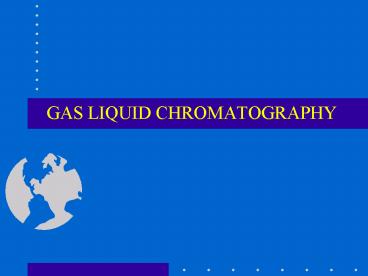GAS LIQUID CHROMATOGRAPHY - PowerPoint PPT Presentation
1 / 31
Title:
GAS LIQUID CHROMATOGRAPHY
Description:
The ions collected on collector or electrode and were recorded on recorder due ... Collector Electrode. Schematic Diagram of Flame Ionization Detector ... – PowerPoint PPT presentation
Number of Views:5466
Avg rating:3.0/5.0
Title: GAS LIQUID CHROMATOGRAPHY
1
GAS LIQUID CHROMATOGRAPHY
2
Gas Liquid Chromatography
- Principles
- Partition of molecules between gas (mobile phase)
and liquid (stationary phase).
3
Most Common Stationary Phases
- 1. Separation of mixture of polar compounds
- Carbowax 20M (polyethylene glycol)
- 2. Separation of mixtures of non-polar compounds
- OV101 or SE-30 (polymer of methylsilicone)
- Methylester of fatty acids
- DEGS (diethylene glycol succinate)
4
Gas Chromatography
Filters/Traps
Data system
Syringe/Sampler
Regulators
Inlets
Detectors
- gas system
- inlet
- column
- detector
- data system
Column
5
Schematic Diagram of Gas Chromatography
6
Detector
- Flame Ionization Detector (Nanogram - ng)
- High temperature of hydrogen flame (H2 O2 N2)
ionizes compounds eluted from column into flame.
The ions collected on collector or electrode and
were recorded on recorder due to electric
current.
7
Schematic Diagram of Flame Ionization Detector
Exhaust
Chimney
Collector Electrode
Igniter
Column
Hydrogen
Effluent
Inlet
8
Thermal Conductivity Detector
Measures the changes of thermal conductivity due
to the sample (mg). Sample can be recovered.
9
Thermal Conductivity Detector
Principal The thermal balance of a heated
filament Electrical power is converted to heat
in a filament and the temperature will climb
until heat power loss form the filament equals
the electrical power input. The filament may
loose heat by radiation to a cooler surface by
conduction to the molecules which contact with
the filament.
10
Thermal Conductivity Basics
When the carrier gas is contaminated by sample
, the cooling effect of the gas changes. The
difference in cooling is used to generate the
detector signal.
The TCD is a nondestructive, concentration
sensing detector. A heated filament is cooled by
the flow of carrier gas.
Flow
Flow
11
Thermal Conductivity Detector
When a separated compound elutes from the column
, the thermal conductivity of the mixture of
carrier gas and compound gas is lowered. The
filament in the sample column becomes hotter than
the control column. The imbalance between
control and sample filament temeprature is
measured by a simple gadget and a signal is
recorded
12
Relative Thermal Conductivity
13
Thermal Conductivity Detector
14
Thermal Conductivity Detector
- Responds to all compounds
- Adequate sensitivity for many compounds
- Good linear range of signal
- Simple construction
- Signal quite stable if carrier gas glow rate,
block temperature, and filament power are
effectively controlled - Nondestructive detection
15
Electron Capture Detector
Analyses for pesticide, Insecticides, vinyl
chloride, and fluorocarbons in foods. Most
sensitive detector (10-12 gram)
16
Electron Capture Detector
ECD detects positive ions of carrier gas by the
anode electrode. 63Ni emits ? particles. Ionizati
on N2 (Carrier gas) ? (e) N2 2e. The
N2 establish a base line X (F, Cl and Br)
containing sample ? (e) ? X- Ion
recombination X- N2 X N2, The
base line due to the N2 will decrease and this
decrease constitutes the signal. The more the
halogen containing X compounds in the sample, the
less the N2 in the detector
17
Electron Capture Detector
18
Electron Capture Detector
19
Chromatogram of Compounds from Fermented Cabbage
20
Chromatogram of Orange Juice Compounds
21
Gas Chromatography Application
22
Semi-Quantitative Analysis of Fatty Acids
C
18
10
C
8
16
Detector Response
Peak Area
6
C
4
14
2
0.5
1.0
3.0
2.0
2.5
1.5
Sample Concentration (mg/ml)
Retention Time
23
Tentative Identification of Unknown Compounds
Mixture of known compounds
Octane
Decane
1.6 min RT
Response
Hexane
GC Retention Time on Carbowax-20 (min)
Unknown compound may be Hexane
Response
1.6 min RT
Retention Time on Carbowax-20 (min)
24
Retention Times
RT 4.0 min on SE-30
Hexane
Response
GC Retention Time on SE-30
RT 4 min on SE-30
Unknown compound
Response
GC Retention Time on SE-30
25
Advantages of Gas Chromatography
- Very good separation
- Time (analysis is short)
- Small sample is needed - ml
- Good detection system
- Quantitatively analyzed
26
Disadvantages of Gas Chromatography
Material has to be volatilized at 250C without
decomposition.
Methylester
Fatty Acids
Reflux
Volatile in Gas
Chromatography
3
Volatile in Gas
Chromatography
27
Gas Chromatogram of Methyl Esters of Fatty Acids
28
Effects of OH groups of Carbohydrates
6
CH
OH
2
O
5
4
1
OH
HO
OH
2
3
OH
29
Derivation of Glucose with Trimethylchlorosilane
Glucose
Trimethylchlorosilane
6
CH
O-Si(CH3)3
2
O
5
5HCl
4
1
O-Si(CH3)3
(CH3)3-Si-O
O-Si(CH3)3
2
3
O-Si(CH3)3
30
Effects of Derivation
- Time consumption
- Side reaction
- Loss of sample
31
(No Transcript)














![Lecture note : Gas chromatography [1] ????????? PowerPoint PPT Presentation](https://s3.amazonaws.com/images.powershow.com/6692254.th0.jpg?_=20150604093)
















